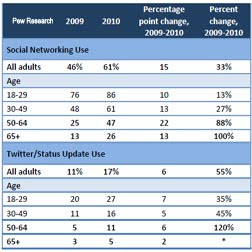
After spending a few hours poking around the first attempt at a social network by Apple, I have to give props to all my friends who have said Apple doesn't understand social. Maybe it will in the future, but it doesn't really understand it today.
Ping has potential, but this launch is best described as a soft open. It seems less than fully functional. And while Steve Jobs described it as Twitter meets Facebook for music, it seems like something else. It feels like a walled fledgling of what we know about networks, crossed with a non-commissioned marketing platform because everything you like comes with a buy button.
And that's the real point, isn't it?
What Apple seemed to miss out of the starting gate is that people don't generally go to this social network to talk about "music" and that social network to talk about "restaurants." That's not a social network. It's a niche forum. And if Apple created anything, it is a password protected forum with a partial social network template laid over the top.
Is that how social networks work? Not really. The current success of Twitter and Facebook illustrates that. Those networks succeeded because there were no limits to what you could talk about. You only needed to show up and find people you knew or wanted to know. It's about people. This is about product.
Specifically, Ping works in exactly the opposite way. You find music and "like" it and then ... um, I would like to say find people to follow but that is a real challenge. Other than three people recommended, your only options are "search" and "email," which are my least two favorite ways to connect with people. (Search is fine, but it's a time waster for social upstarts.) The only other way to pay attention to who other people follow, too.
The Facebook connect feature seemed promising before it was removed late in the game. It was removed so late in the game that the Ping intro page still tells you that you can connect to Facebook. Except, you can't. So don't look. (You can find me if you like. Search for "Rich Becker" on Ping.)
By the way, did I say search for music? Not every album and artist has a like button. I know, because the first thing I thought to do is travel down the list of our recent reviews from Liquid [Hip] and quickly connect them up before someone does start to follow me. About 30 percent didn't have like buttons.
I suppose that makes sense. We focus on cool, not popular. Some recent covers aren't cool enough to like, apparently. And that makes the entire platform, as it exists today, loaded down with tighter rules than Fight Club. Case in point ...
The Rules Of Ping Club.
1. The first rule of Ping club is you do not link to Ping club and you do not link out of Ping club.
2. The second rule of Ping club is, you DO NOT link in or out of Ping club.
3. If someone lags because the interface is painfully slow, the conversation is over.
4. Two people connect at one time, if you find them.
5. One "like" at a time and you won't remember what those were 20 "likes" from now.
6. No frills, friendships, updates. This is about music.
7. You'll participate as long as you have to, three times longer than anywhere else (see 3).
8. If this is your first time on Ping, you have to do something.
Look, most people consider me a fan of Apple, given I still have a working monochrome Mac Classic on my shelf. The same one I used to start Copywrite, Ink. almost 20 years ago. And, since we started Liquid [Hip], I spend even more time on iTunes because it has a solid storefront to keep track of new music, movies, etc. So, I'll give Ping some time to flush itself out. It has potential.
However, I'm not so enamored by any brand to believe this launch was ready for prime time. It's a network of sorts, but it's not social. At least, not yet. To date, the only thing inspiring about it is some inspiration to write up what Ping could have been. And maybe I'll do that next week.
One redeeming feature? The concert listings is a cool idea. But it would have been brilliant if there was some feature to coordinate concert attendance with your circle of friends. Moving the online world offline is part of our connected futures.
Related Articles And Posts.
• 10 Questions About Ping, Apple's Social Network For Music.
• Apple's Ping Social Network Is Actually Good, And It Has Huge Potential.
• Facebook’s Apple Ping demands were ‘too onerous’, says Jobs
















